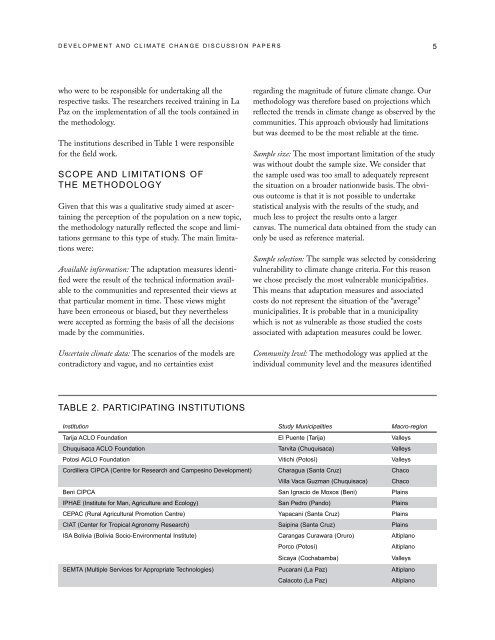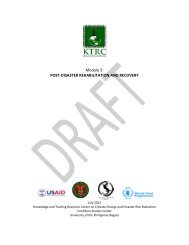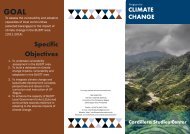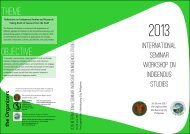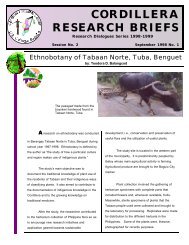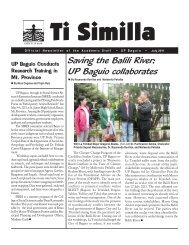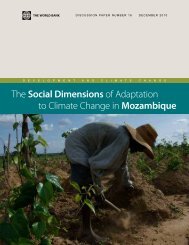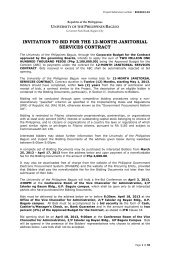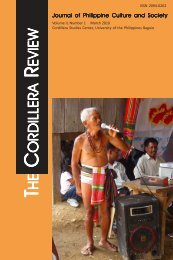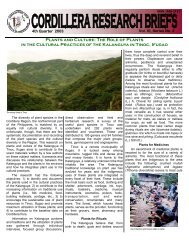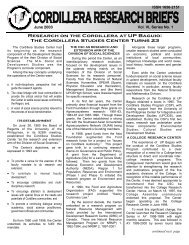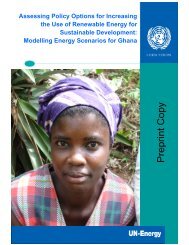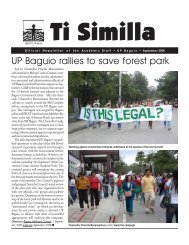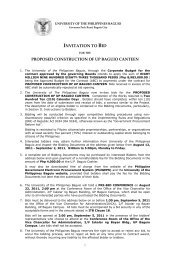EACC Bolivia
EACC Bolivia
EACC Bolivia
You also want an ePaper? Increase the reach of your titles
YUMPU automatically turns print PDFs into web optimized ePapers that Google loves.
d E v E l o p m E n t A n d c l i m A t E c h A n g E d i s c U s s i o n pA p E R s<br />
5<br />
who were to be responsible for undertaking all the<br />
respective tasks. The researchers received training in La<br />
Paz on the implementation of all the tools contained in<br />
the methodology.<br />
The institutions described in Table 1 were responsible<br />
for the field work.<br />
scopE And limitAtions of<br />
thE mEthodology<br />
Given that this was a qualitative study aimed at ascertaining<br />
the perception of the population on a new topic,<br />
the methodology naturally reflected the scope and limitations<br />
germane to this type of study. The main limitations<br />
were:<br />
Available information: The adaptation measures identified<br />
were the result of the technical information available<br />
to the communities and represented their views at<br />
that particular moment in time. These views might<br />
have been erroneous or biased, but they nevertheless<br />
were accepted as forming the basis of all the decisions<br />
made by the communities.<br />
Uncertain climate data: The scenarios of the models are<br />
contradictory and vague, and no certainties exist<br />
regarding the magnitude of future climate change. Our<br />
methodology was therefore based on projections which<br />
reflected the trends in climate change as observed by the<br />
communities. This approach obviously had limitations<br />
but was deemed to be the most reliable at the time.<br />
Sample size: The most important limitation of the study<br />
was without doubt the sample size. We consider that<br />
the sample used was too small to adequately represent<br />
the situation on a broader nationwide basis. The obvious<br />
outcome is that it is not possible to undertake<br />
statistical analysis with the results of the study, and<br />
much less to project the results onto a larger<br />
canvas. The numerical data obtained from the study can<br />
only be used as reference material.<br />
Sample selection: The sample was selected by considering<br />
vulnerability to climate change criteria. For this reason<br />
we chose precisely the most vulnerable municipalities.<br />
This means that adaptation measures and associated<br />
costs do not represent the situation of the “average”<br />
municipalities. It is probable that in a municipality<br />
which is not as vulnerable as those studied the costs<br />
associated with adaptation measures could be lower.<br />
Community level: The methodology was applied at the<br />
individual community level and the measures identified<br />
tABlE 2. pARticipAting institUtions<br />
Institution Study Municipalities Macro-region<br />
tarija Aclo foundation El puente (tarija) valleys<br />
chuquisaca Aclo foundation tarvita (chuquisaca) valleys<br />
potosi Aclo foundation vitichi (potosí) valleys<br />
cordillera cipcA (centre for Research and campesino development) charagua (santa cruz) chaco<br />
villa vaca guzman (chuquisaca) chaco<br />
Beni cipcA san ignacio de moxos (Beni) plains<br />
iphAE (institute for man, Agriculture and Ecology) san pedro (pando) plains<br />
cEpAc (Rural Agricultural promotion centre) yapacani (santa cruz) plains<br />
ciAt (center for tropical Agronomy Research) saipina (santa cruz) plains<br />
isA <strong>Bolivia</strong> (<strong>Bolivia</strong> socio-Environmental institute) carangas curawara (oruro) Altiplano<br />
porco (potosí)<br />
Altiplano<br />
sicaya (cochabamba)<br />
valleys<br />
sEmtA (multiple services for Appropriate technologies) pucarani (la paz) Altiplano<br />
calacoto (la paz)<br />
Altiplano


